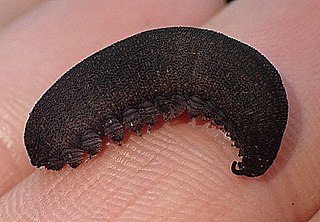Related Research Articles
Peripatoides suteri is a species of velvet worm in the Peripatopsidae family. This species is ovoviviparous has 16 pairs of legs. It is endemic to New Zealand.

Peripatopsidae is one of the two living velvet worm families.

Occiperipatoides is a monospecific genus of velvet worm containing the single species Occiperipatoides gilesii. This genus is ovoviviparous and found in Western Australia. The genus is part of the ancient phylum Onychophora that contains soft-bodied, many-legged relatives of arthropods known commonly as velvet worms.
Cephalofovea is a genus of velvet worms in the Peripatopsidae family. All species in this genus are ovoviviparous and have 15 pairs of oncopods (legs), and both sexes possess a pitted-head which the male everts and uses to pass his spermatophore to the female. They are found in New South Wales, Australia.
Florelliceps is a monospecific genus of ovoviviparous velvet worm containing the single species Florelliceps stutchburyae. This species is brown with 15 pairs of oncopods (legs). During mating, the male of this species uses a structure on his head to place a spermataphore on the gonopore of the female. The type locality is Mount Warning, New South Wales, Australia.

Euperipatoides rowelli is an ovoviviparous species of velvet worm of the Peripatopsidae family. It is found in New South Wales and the Australian Capital Territory.
Epiperipatus imthurni is a species of velvet worm in the family Peripatidae. The type locality is in Guyana. No males have been recorded from this species. Females have 28 to 32 pairs of legs, usually 30 or 31. Females from Trinidad were shown to reproduce via parthenogenesis; the only velvet worm known to do so.
Epiperipatus barbadensis is a species of velvet worm in the Peripatidae family. Females of this species have 31 pairs of legs. The type locality is in Barbados.
Epiperipatus broadwayi is a species of velvet worm in the Peripatidae family. This species has 29 to 34 pairs of legs. The type locality is in Tobago.
Macroperipatus torquatus is a species of velvet worm in the Peripatidae family. This species has a brown or red back with a bright yellow collar, a black head with black antennae, a white underside with a red tint, and 37 to 42 pairs of legs. This species is found in Trinidad.
Opisthopatus cinctipes is a species of velvet worm in the Peripatopsidae family. This species has 16 pairs of legs, all with claws and all used for walking. The type locality is in South Africa.
Cephalofovea cameroni is a species of ovoviviparous velvet worm in the family Peripatopsidae. This species has 15 pairs of oncopods (legs) and lives in rotting logs and leaf litter. The type locality is Rydal, New South Wales, Australia. Like all members of the genus Cephalofovea, both sexes of C. cameroni have a furrow on the head, between the antennae, which the male everts to carry his spermatophore to the female.
Cephalofovea clandestina is a species of ovoviviparous velvet worm in the family Peripatopsidae. This species has 15 pairs of oncopods (legs) and lives in rotting logs and leaf litter. The type locality is Kanangra-Boyd National Park, New South Wales, Australia. Like all members of the genus Cephalofovea, both sexes of C. clandestina have a furrow on the head, between the antennae, which the male everts to carry his spermatophore to the female.
Cephalofovea pavimenta is a species of velvet worm in the Peripatopsidae family. It is only known from the type locality; Mount Canobolas in New South Wales, Australia.
Ooperipatellus insignis is a species of velvet worm in the family Peripatopsidae. This species has 14 pairs of legs and is found in Victoria, Australia.

Ooperipatellus nanus is a species of velvet worm in the family Peripatopsidae. This species is endemic to New Zealand and is found in the South Island.

Peripatopsis moseleyi is a species of velvet worm in the Peripatopsidae family. Females of this species have 19 to 23 pairs of legs with claws ; males have 20 to 24 pairs of legs with claws. The type locality is in South Africa.
Peripatopsis sedgwicki is a species of velvet worm in the Peripatopsidae family. This species can have either 20 or 21 pairs of legs, but descriptions usually report 20 pairs of clawed legs. The type locality is in South Africa.
Peripatopsis stelliporata is a species of velvet worm in the Peripatopsidae family. This species has 17 to 19 pairs of legs, usually 18, with the last leg pair reduced more in males than in females. The type locality is in South Africa.

The Knysna velvet worm is a species of velvet worm in the Peripatopsidae family. This species has 17 pairs of legs with claws, with the last pair of legs reduced. Peripatopsis clavigera is found in subtropical or tropical moist montane forests of South Africa.
References
- ↑ Oliveira I. S.; Hering L.; Mayer, G. "Updated Onychophora checklist". Onychophora Website. Retrieved 24 November 2016.
- ↑ Reid, A.L.; Tait, N.N.; Briscoe, D.A.; Rowell, D.M. (1995-05-01). "Morphological, cytogenetic and allozymic variation within Cephalofovea (Onychophora: Peripatopsidae) with descriptions of three new species". Zoological Journal of the Linnean Society. 114 (1): 115–138. doi:10.1111/j.1096-3642.1995.tb00116.x. ISSN 0024-4082.
- ↑ Oliveira, I. S.; Read, V. M. S. J.; Mayer, G. (2012). "A world checklist of Onychophora (velvet worms), with notes on nomenclature and status of names". ZooKeys (211): 1–70. doi:10.3897/zookeys.211.3463. PMC 3426840 . PMID 22930648.